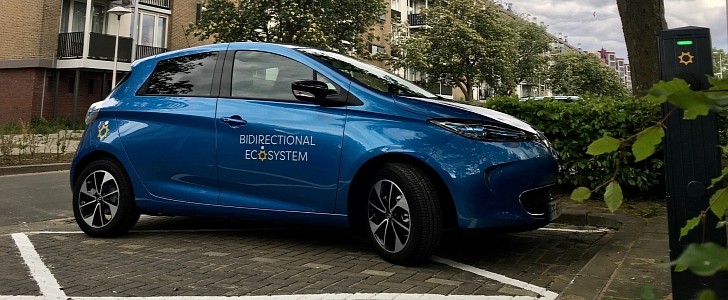BEVs (battery electric vehicles) are not only machines that move solely with electricity. They can also be massive moving power banks that can help cities be more independent when it comes to energy. Utrecht, in the Netherlands, wants to become the first bidirectional city in the world, as Fully Charged demonstrates in its latest video.
If you are not familiar with the term, it means that Utrecht will not only be able to charge its electric cars. It will also get electricity from them. Although that seems like something easy to do, it is far from being that simple.
The main problem involved with this ambition is that few electric cars currently have that capability. Apart from the Nissan Leaf, Renault ZOE, Hyundai Ioniq 5, Kia EV6, Genesis GV60, BYD Dolphin, and the Lucid Air, we’re not aware of many other electric cars that can feed the grid as much as they can feed on the energy it provides. No Tesla can do that, for example.
There’s a simple reason for some electric cars not to do that: it reduces the lifespan of their battery packs. Whether it is powering the wheels or feeding a house with energy, a battery pack has a limited number of charging and discharging cycles that it can achieve.
According to Robin Berg, director of We Drive Solar, about 10,000 electric cars with bidirectional capacity would be enough to balance Utrecht. The Dutch city now has 140,000 vehicles registered in total, which makes the necessary EVs to balance the grid just a tiny fraction of that fleet.
With that many vehicles connected to bidirectional smart grids or chargers, each of these electric cars would just have to spend a bit of the energy they stored during the day. That would also prevent them from spending their battery packs’ capacity more than it would be advisable.
We Drive Solar is a company that has associated with Utrecht to pursue the goal of making the city the largest one with bidirectional capacity. The video was shot in one of its parking spots powered by solar energy. It counts on 2,160 solar panels that can produce 850,000 kWh per year on average and 1 million kWh per year on a sunny one.
If you think it through, Utrecht’s ambition is not to become the world’s largest bidirectional city. It is to be the guinea pig in establishing how to do it right. When it achieves that, the Dutch city will be happy to be beaten by larger cities: that will mean that the idea worked fine. With new battery tech such as solid-state cells, charging and discharging may cease to be a concern, making electric cars an integral part of power grids. We can’t wait to see that happen.
The main problem involved with this ambition is that few electric cars currently have that capability. Apart from the Nissan Leaf, Renault ZOE, Hyundai Ioniq 5, Kia EV6, Genesis GV60, BYD Dolphin, and the Lucid Air, we’re not aware of many other electric cars that can feed the grid as much as they can feed on the energy it provides. No Tesla can do that, for example.
There’s a simple reason for some electric cars not to do that: it reduces the lifespan of their battery packs. Whether it is powering the wheels or feeding a house with energy, a battery pack has a limited number of charging and discharging cycles that it can achieve.
According to Robin Berg, director of We Drive Solar, about 10,000 electric cars with bidirectional capacity would be enough to balance Utrecht. The Dutch city now has 140,000 vehicles registered in total, which makes the necessary EVs to balance the grid just a tiny fraction of that fleet.
With that many vehicles connected to bidirectional smart grids or chargers, each of these electric cars would just have to spend a bit of the energy they stored during the day. That would also prevent them from spending their battery packs’ capacity more than it would be advisable.
We Drive Solar is a company that has associated with Utrecht to pursue the goal of making the city the largest one with bidirectional capacity. The video was shot in one of its parking spots powered by solar energy. It counts on 2,160 solar panels that can produce 850,000 kWh per year on average and 1 million kWh per year on a sunny one.
If you think it through, Utrecht’s ambition is not to become the world’s largest bidirectional city. It is to be the guinea pig in establishing how to do it right. When it achieves that, the Dutch city will be happy to be beaten by larger cities: that will mean that the idea worked fine. With new battery tech such as solid-state cells, charging and discharging may cease to be a concern, making electric cars an integral part of power grids. We can’t wait to see that happen.










